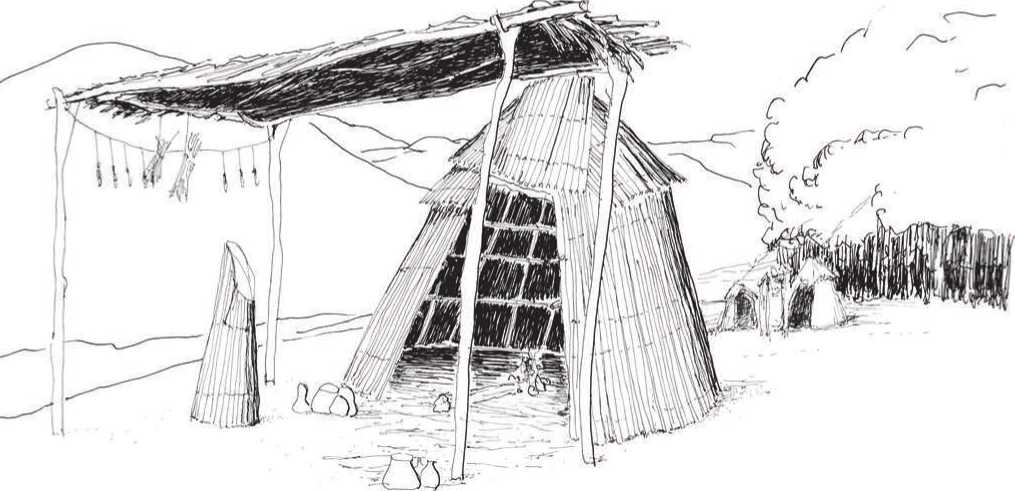The Yokuts (“People”) thrived in the upland river areas of central California and can be considered a southern variant to the great coastal civilization. They were less oriented to the ocean, which here was significantly less rich than farther north, and more focused on salmon and acorns, both of which were in plentiful supply. Using harpoons and dragnets, they caught, of course, spawning salmon in the fall and spring, but here the cedar forest gives way to an oak forest that stretches north-south on the western slopes of the Rocky Mountains from Seattle to northern California. From these extensive groves, they gathered great quantities of acorns that were ground into meal and cooked as a thick soup or gruel. Most species of oak were used, but they varied in nutritional value, moisture content, and texture. Tan oak and black oak both have large acorns, with significant tannins (insect repellent), low moisture, good nutrition, and good-quality flour when pounded. Valley oak is lowest in nutrition and highest in moisture of the commonly eaten acorns, and required the most efibrt to dry. Gold cup oak was avoided, as it produced poor-quality flour. In the southern deserts, pine nuts took the place of acorns.
Because acorns ripen but once a year, in spring, and then in abundance, special provisions had to be made to store them. Once harvested, they were dried by spreading them out in the sun on a rock. While being stored, the nuts had to be protected against moisture, rodents, and birds. Strategies varied according to climate, with rodents being more of a threat in the desert, while moisture was the principal threat in the rainy north. To solve the problem, the granaries were lined with plants, which either masked the smell of the food or made it hard for pests to burrow through. To deal with the moisture, granaries were elevated. Families in the Sierra Nevada foothills are thought to have eaten around 500 pounds of acorns per family member per year. That means a family of five would need over a ton.
To build the granary, straight willow shoots about 1 inch in diameter were stuck into the ground in a circle and twined together at the bottom to about one-third of the way up. Rocks weighed the structure down and protected the contents from moisture. When filled, the shoots were tied together at the top to make a pointed cone that was sealed with thatch or deer hide. Throughout the desert areas to the south, the typical storage structure was a platform or large boulder with a coiled globular basket made with very thick sidewalls of tough or bitter material such as willow, known to repel insects. Some were more conical, others more open and fitted with a lid. In other places, baskets were hung from a tree or from a structure of poles.28
The acorns were first milled in areas close to the village on rocky outcrops, where today telltale traces of this activity are found in the form of dozens of concavities about 40 centimeters across, where the millstone rubbed against the rock. Next the bitter tannin had to be removed by soaking the nuts in a leaf-lined depression or basin in sand. Since frequent doses of water were needed, these basins were located near streams, and were about 2 or 3 feet in diameter. They were deep enough for about 2 or 3 inches of warm water to be poured over the meal and allowed to percolate through it, thus drawing os' the tannic acid. The resultant meal was left: to harden, creating a cake that was broken up and eaten without further processing as “acorn bread.” The cake could be repulverized and roasted, but the preferred method of cooking seems to have been by boiling it to mush in water-tight baskets.29
The Yokuts lived in conical houses of vertical branches bound together horizontally with hoops at regular intervals. The frame was thatched or covered with mats of river reeds. The fire at the center was fed by a log pushed in from the doorway as needed. The doorway was sometimes protected by a rain shed with hanging mats. The northern Yokuts built villages with loose arrangements of dwellings, whereas the southern Yokuts built their houses in a single, regular row. The floor might be excavated 20 centimeters or so in pit-style tradition. Besides dwellings, there appear to have been ceremonial assembly houses, similarly built but larger. Most settlements, at least the principal ones, sat perched on top of low mounds, on or near the banks of large watercourses (Figure 5.32).
Figure 5.32: Yokut hut and acorn basket, California, U. S.A. Source: Mark Jarzombek

Not much is known about the specifics of their religious practices. They had, for example, a ceremony centering around the drinking of a decoction prepared from the roots of the datura plant, which contain an alkaloid that produces stupor and visions. Young adults drank the mixture in order to gain supernatural visions. Different subgroups with different totemic allegiances served different purposes in the community. At the time of acorn harvesting, for example, members of the Bear lineage performed a dance and a feast was provided by all the Bear people.8”




 World History
World History









